SAAB 9-3 2003 Owner's Guide
Manufacturer: SAAB, Model Year: 2003, Model line: 9-3, Model: SAAB 9-3 2003Pages: 256, PDF Size: 21.66 MB
Page 31 of 256
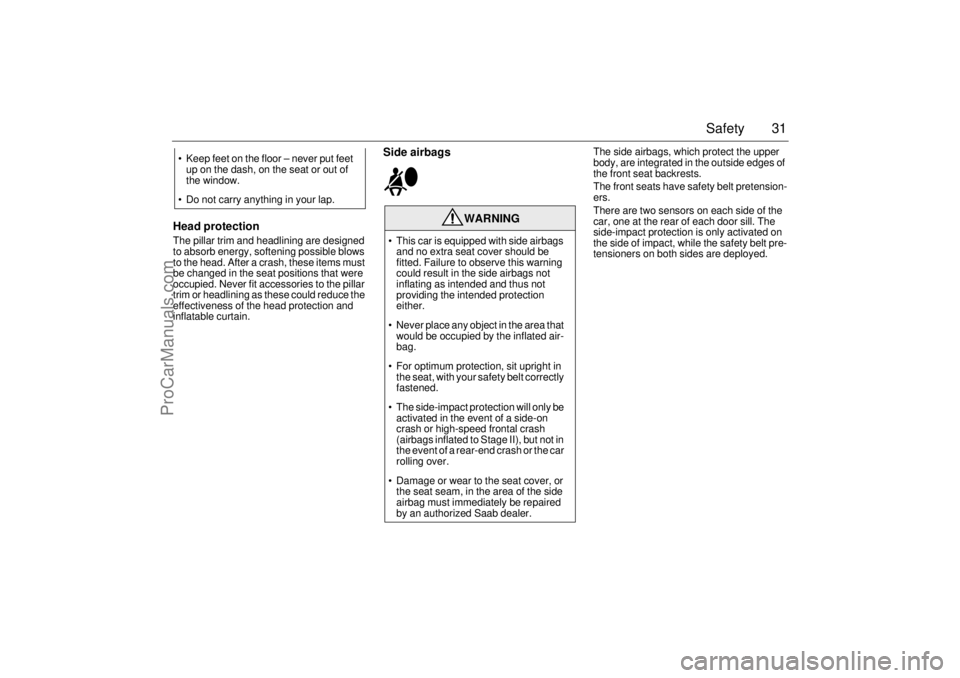
31 Safety
Head protectionThe pillar trim and headlining are designed
to absorb energy, softening possible blows
to the head. After a crash, these items must
be changed in the seat positions that were
occupied. Never fit accessories to the pillar
trim or headlining as these could reduce the
effectiveness of the head protection and
inflatable curtain.
Side airbags
The side airbags, which protect the upper
body, are integrated in the outside edges of
the front seat backrests.
The front seats have safety belt pretension-
ers.
There are two sensors on each side of the
car, one at the rear of each door sill. The
side-impact protection is only activated on
the side of impact, while the safety belt pre-
tensioners on both sides are deployed. Keep feet on the floor – never put feet
up on the dash, on the seat or out of
the window.
Do not carry anything in your lap.
WARNING
This car is equipped with side airbags
and no extra seat cover should be
fitted. Failure to observe this warning
could result in the side airbags not
inflating as intended and thus not
providing the intended protection
either.
Never place any object in the area that
would be occupied by the inflated air-
bag.
For optimum protection, sit upright in
the seat, with your safety belt correctly
fastened.
The side-impact protection will only be
activated in the event of a side-on
crash or high-speed frontal crash
(airbags inflated to Stage II), but not in
the event of a rear-end crash or the car
rolling over.
Damage or wear to the seat cover, or
the seat seam, in the area of the side
airbag must immediately be repaired
by an authorized Saab dealer.
ProCarManuals.com
Page 32 of 256
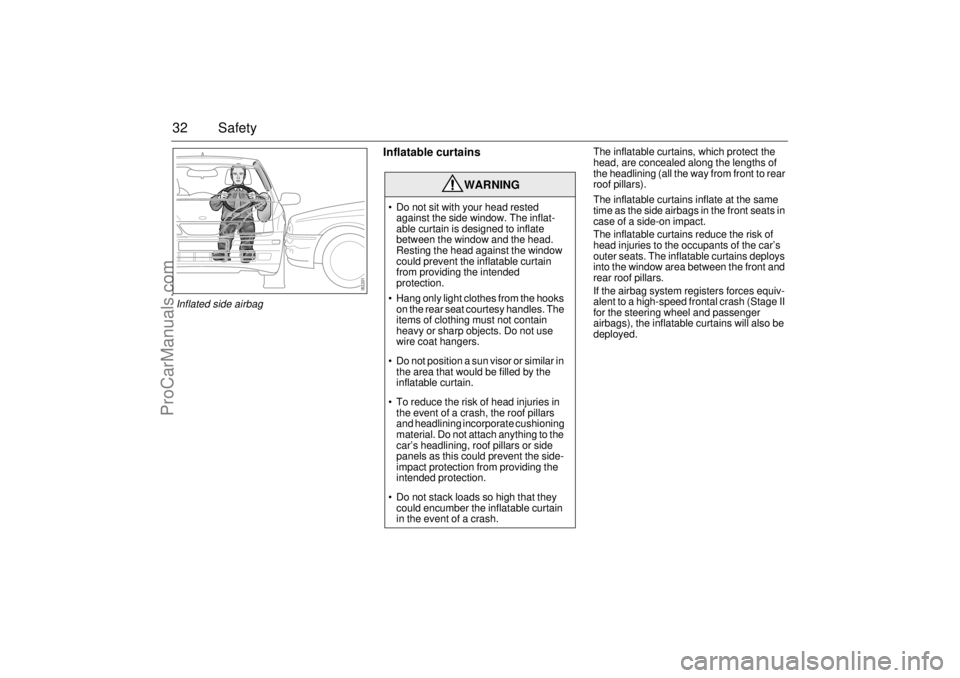
32 Safety
Inflatable curtains
The inflatable curtains, which protect the
head, are concealed along the lengths of
the headlining (all the way from front to rear
roof pillars).
The inflatable curtains inflate at the same
time as the side airbags in the front seats in
case of a side-on impact.
The inflatable curtains reduce the risk of
head injuries to the occupants of the car’s
outer seats. The inflatable curtains deploys
into the window area between the front and
rear roof pillars.
If the airbag system registers forces equiv-
alent to a high-speed frontal crash (Stage II
for the steering wheel and passenger
airbags), the inflatable curtains will also be
deployed.
WARNING
Do not sit with your head rested
against the side window. The inflat-
able curtain is designed to inflate
between the window and the head.
Resting the head against the window
could prevent the inflatable curtain
from providing the intended
protection.
Hang only light clothes from the hooks
on the rear seat courtesy handles. The
items of clothing must not contain
heavy or sharp objects. Do not use
wire coat hangers.
Do not position a sun visor or similar in
the area that would be filled by the
inflatable curtain.
To reduce the risk of head injuries in
the event of a crash, the roof pillars
and headlining incorporate cushioning
material. Do not attach anything to the
car’s headlining, roof pillars or side
panels as this could prevent the side-
impact protection from providing the
intended protection.
Do not stack loads so high that they
could encumber the inflatable curtain
in the event of a crash.
Inflated side airbag
ProCarManuals.com
Page 33 of 256
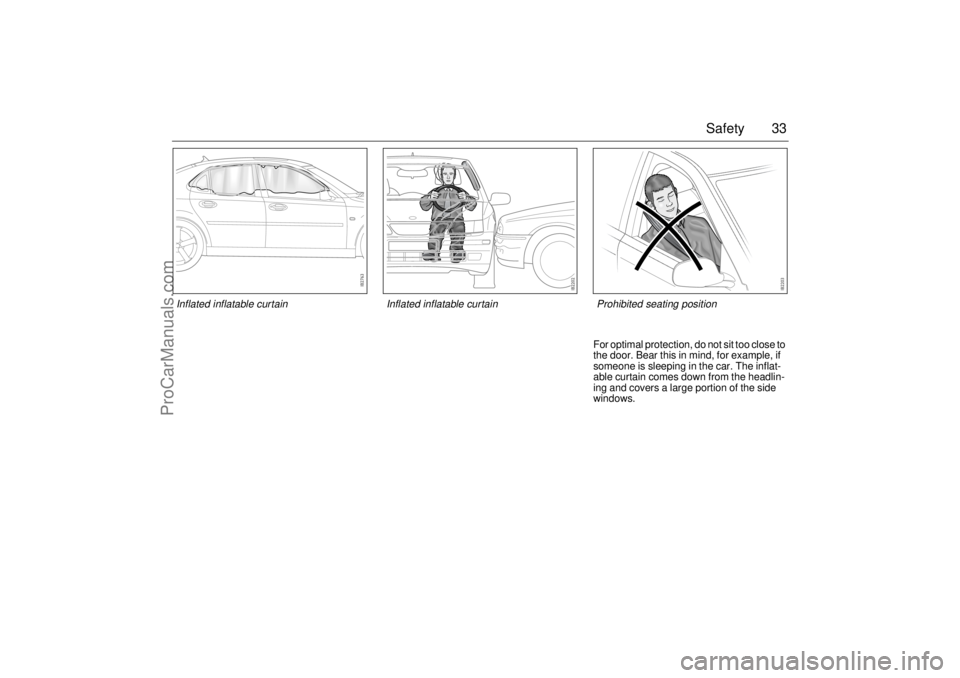
33 Safety
For optimal protection, do not sit too close to
the door. Bear this in mind, for example, if
someone is sleeping in the car. The inflat-
able curtain comes down from the headlin-
ing and covers a large portion of the side
windows.Prohibited seating position
Inflated inflatable curtain
Inflated inflatable curtain
ProCarManuals.com
Page 34 of 256
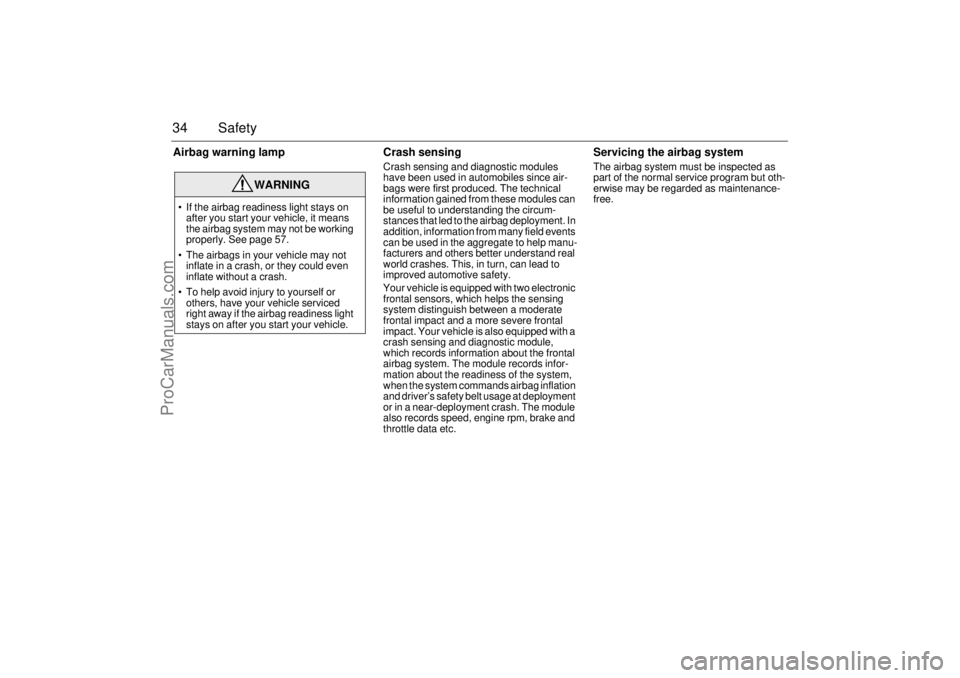
34 SafetyAirbag warning lamp Crash sensing
Crash sensing and diagnostic modules
have been used in automobiles since air-
bags were first produced. The technical
information gained from these modules can
be useful to understanding the circum-
stances that led to the airbag deployment. In
addition, information from many field events
can be used in the aggregate to help manu-
facturers and others better understand real
world crashes. This, in turn, can lead to
improved automotive safety.
Your vehicle is equipped with two electronic
frontal sensors, which helps the sensing
system distinguish between a moderate
frontal impact and a more severe frontal
impact. Your vehicle is also equipped with a
crash sensing and diagnostic module,
which records information about the frontal
airbag system. The module records infor-
mation about the readiness of the system,
when the system commands airbag inflation
and driver’s safety belt usage at deployment
or in a near-deployment crash. The module
also records speed, engine rpm, brake and
throttle data etc.
Servicing the airbag systemThe airbag system must be inspected as
part of the normal service program but oth-
erwise may be regarded as maintenance-
free.
WARNING
If the airbag readiness light stays on
after you start your vehicle, it means
the airbag system may not be working
properly. See page 57.
The airbags in your vehicle may not
inflate in a crash, or they could even
inflate without a crash.
To help avoid injury to yourself or
others, have your vehicle serviced
right away if the airbag readiness light
stays on after you start your vehicle.
ProCarManuals.com
Page 35 of 256
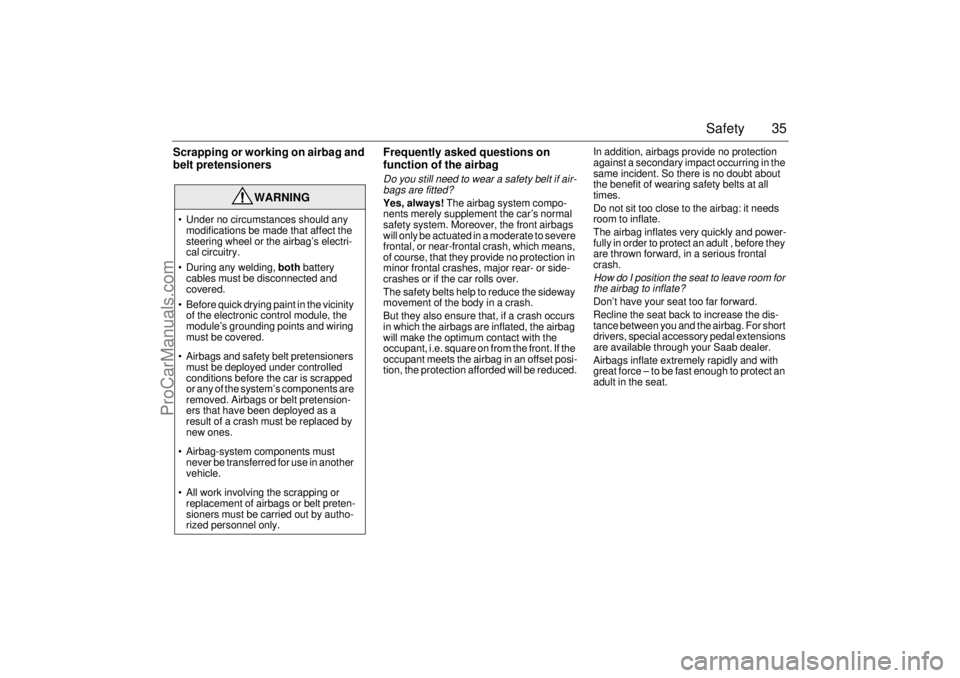
35 Safety
Scrapping or working on airbag and
belt pretensionersFrequently asked questions on
function of the airbag
Do you still need to wear a safety belt if air-
bags are fitted?Yes, always! The airbag system compo-
nents merely supplement the car’s normal
safety system. Moreover, the front airbags
will only be actuated in a moderate to severe
frontal, or near-frontal crash, which means,
of course, that they provide no protection in
minor frontal crashes, major rear- or side-
crashes or if the car rolls over.
The safety belts help to reduce the sideway
movement of the body in a crash.
But they also ensure that, if a crash occurs
in which the airbags are inflated, the airbag
will make the optimum contact with the
occupant, i.e. square on from the front. If the
occupant meets the airbag in an offset posi-
tion, the protection afforded will be reduced.In addition, airbags provide no protection
against a secondary impact occurring in the
same incident. So there is no doubt about
the benefit of wearing safety belts at all
times.
Do not sit too close to the airbag: it needs
room to inflate.
The airbag inflates very quickly and power-
fully in order to protect an adult , before they
are thrown forward, in a serious frontal
crash.
How do I position the seat to leave room for
the airbag to inflate?Don’t have your seat too far forward.
Recline the seat back to increase the dis-
tance between you and the airbag. For short
drivers, special accessory pedal extensions
are available through your Saab dealer.
Airbags inflate extremely rapidly and with
great force – to be fast enough to protect an
adult in the seat.
WARNING
Under no circumstances should any
modifications be made that affect the
steering wheel or the airbag’s electri-
cal circuitry.
During any welding, both battery
cables must be disconnected and
covered.
Before quick drying paint in the vicinity
of the electronic control module, the
module’s grounding points and wiring
must be covered.
Airbags and safety belt pretensioners
must be deployed under controlled
conditions before the car is scrapped
or any of the system’s components are
removed. Airbags or belt pretension-
ers that have been deployed as a
result of a crash must be replaced by
new ones.
Airbag-system components must
never be transferred for use in another
vehicle.
All work involving the scrapping or
replacement of airbags or belt preten-
sioners must be carried out by autho-
rized personnel only.
ProCarManuals.com
Page 36 of 256

36 SafetyWhen do the airbags in the steering wheel
and passenger side of the dash board
inflate? The airbag will only be inflated under certain
predetermined conditions in a moderate to
severe frontal, or near-frontal crash,
depending on such factors as the force and
angle of the impact, the speed of the car on
impact, and the resistance to deformation of
the impacting object.
The airbag can only be activated once in the
same incident.
Do not attempt to drive the car after an
airbag has been inflated, even if it is possi-
ble.What won’t trigger the airbag? The airbag will not be activated in all frontal
crashes. For instance, if the car has hit
something relatively soft and yielding (e.g. a
snow drift or a hedge) or a solid object at a
low impact speed, the airbag will not neces-
sarily be triggered.
How loud is the inflation? The noise of the inflation is certainly loud,
but it is of an very short duration and will not
damage your hearing. For a short time after-
wards you could experience a buzzing
noise in your ears.
Most people who have experienced it
cannot remember the noise of the inflation
at all – all they remember is the noise of the
crash. Can you still use a child seat in the front if a
passenger airbag is installed? Definitely not!
Children 12 and under or shorter
than55 inches (140 cn) can be killed by the
airbag.
The back seat is the safest place for chil-
dren.
Never put a rear-facing child seat in the
front.
Sit as far back as possible from the air bag.
Always use seat belts and child restraints.
What should I do if the AIR-BAG warning
light comes on? If the warning light is on, it means that a fault
has been detected in the system. The
airbag cannot be relied on to operate as
intended and it might even be activated
erroneously. You should therefore take the
car to an authorized Saab dealer as soon as
possible.Are the dust and fumes given off when the
airbag operates at all harmful? Most people who have remained in a car
with little or no ventilation for several min-
utes complained only of minor irritation of
the throat and eyes. Avoid as much as pos-
sible getting dust on your skin as there is a
risk of skin irritation.
If you suffer from asthma, the incident may
bring on an attack, in which case you should
follow the normal procedure advised by
your doctor. It is advisable to consult a
doctor afterwards.
ProCarManuals.com
Page 37 of 256
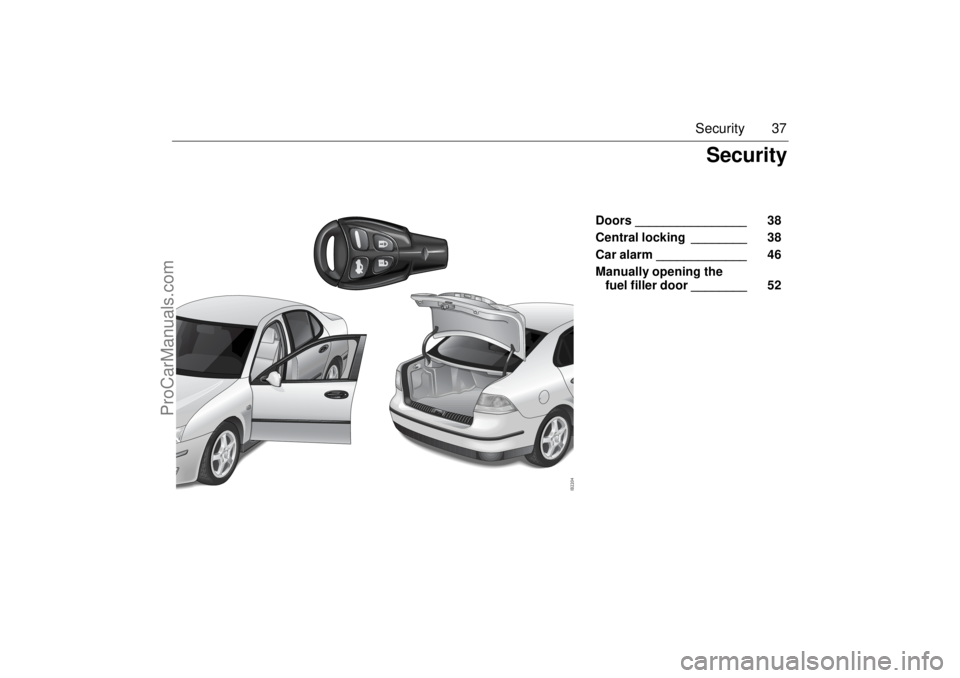
37 Security
Doors ________________ 38
Central locking ________ 38
Car alarm _____________ 46
Manually opening the
fuel filler door ________ 52
Security
ProCarManuals.com
Page 38 of 256
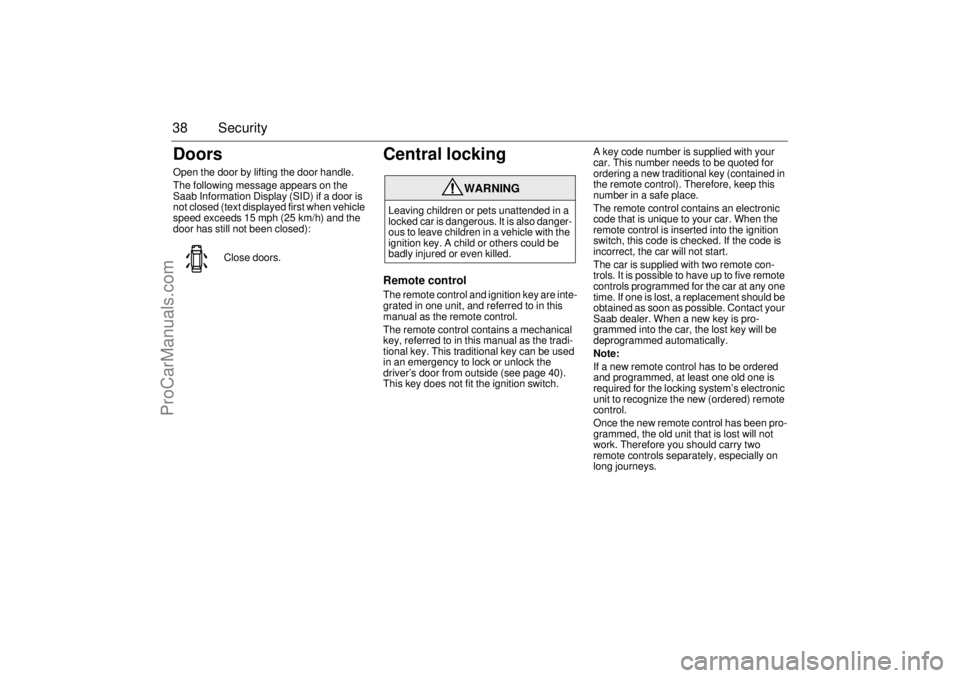
38 SecurityDoorsOpen the door by lifting the door handle.
The following message appears on the
Saab Information Display (SID) if a door is
not closed (text displayed first when vehicle
speed exceeds 15 mph (25 km/h) and the
door has still not been closed):
Central lockingRemote controlThe remote control and ignition key are inte-
grated in one unit, and referred to in this
manual as the remote control.
The remote control contains a mechanical
key, referred to in this manual as the tradi-
tional key. This traditional key can be used
in an emergency to lock or unlock the
driver’s door from outside (see page 40).
This key does not fit the ignition switch.A key code number is supplied with your
car. This number needs to be quoted for
ordering a new traditional key (contained in
the remote control). Therefore, keep this
number in a safe place.
The remote control contains an electronic
code that is unique to your car. When the
remote control is inserted into the ignition
switch, this code is checked. If the code is
incorrect, the car will not start.
The car is supplied with two remote con-
trols. It is possible to have up to five remote
controls programmed for the car at any one
time. If one is lost, a replacement should be
obtained as soon as possible. Contact your
Saab dealer. When a new key is pro-
grammed into the car, the lost key will be
deprogrammed automatically.
Note:
If a new remote control has to be ordered
and programmed, at least one old one is
required for the locking system’s electronic
unit to recognize the new (ordered) remote
control.
Once the new remote control has been pro-
grammed, the old unit that is lost will not
work. Therefore you should carry two
remote controls separately, especially on
long journeys. Close doors.
WARNING
Leaving children or pets unattended in a
locked car is dangerous. It is also danger-
ous to leave children in a vehicle with the
ignition key. A child or others could be
badly injured or even killed.
ProCarManuals.com
Page 39 of 256
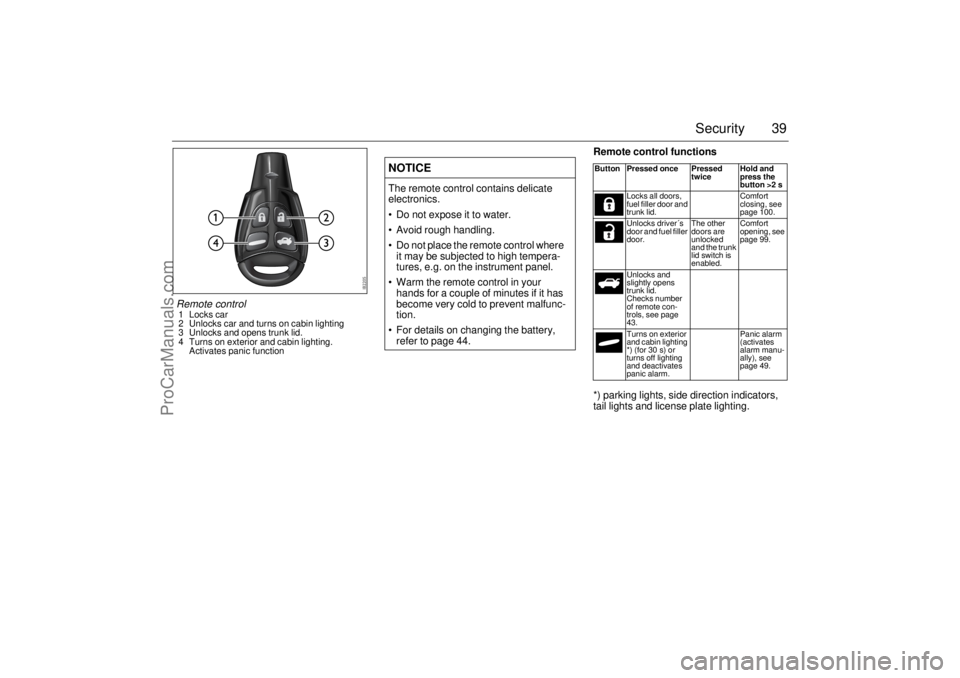
39 Security
Remote control functions
*) parking lights, side direction indicators,
tail lights and license plate lighting.
NOTICEThe remote control contains delicate
electronics.
Do not expose it to water.
Avoid rough handling.
Do not place the remote control where
it may be subjected to high tempera-
tures, e.g. on the instrument panel.
Warm the remote control in your
hands for a couple of minutes if it has
become very cold to prevent malfunc-
tion.
For details on changing the battery,
refer to page 44.
Button Pressed once Pressed
twiceHold and
press the
button >2 s
Locks all doors,
fuel filler door and
trunk lid.Comfort
closing, see
page 100.
Unlocks driver´s
door and fuel filler
door.The other
doors are
unlocked
and the trunk
lid switch is
enabled.Comfort
opening, see
page 99.
Unlocks and
slightly opens
trunk lid.
Checks number
of remote con-
trols, see page
43.
Turns on exterior
and cabin lighting
*) (for 30 s) or
turns off lighting
and deactivates
panic alarm.Panic alarm
(activates
alarm manu-
ally), see
page 49.
Remote control1 Locks car
2 Unlocks car and turns on cabin lighting
3 Unlocks and opens trunk lid.
4 Turns on exterior and cabin lighting.
Activates panic function
ProCarManuals.com
Page 40 of 256
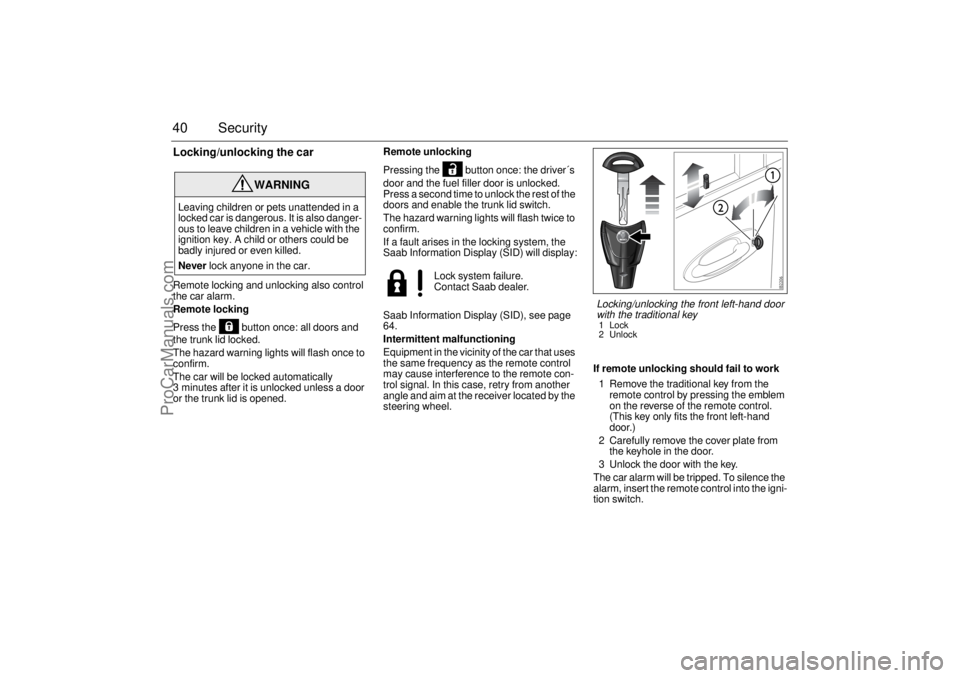
40 SecurityLocking/unlocking the carRemote locking and unlocking also control
the car alarm.
Remote locking
Press the button once: all doors and
the trunk lid locked.
The hazard warning lights will flash once to
confirm.
The car will be locked automatically
3 minutes after it is unlocked unless a door
or the trunk lid is opened.Remote unlocking
Pressing the button once: the driver´s
door and the fuel filler door is unlocked.
Press a second time to unlock the rest of the
doors and enable the trunk lid switch.
The hazard warning lights will flash twice to
confirm.
If a fault arises in the locking system, the
Saab Information Display (SID) will display:
Saab Information Display (SID), see page
64.
Intermittent malfunctioning
Equipment in the vicinity of the car that uses
the same frequency as the remote control
may cause interference to the remote con-
trol signal. In this case, retry from another
angle and aim at the receiver located by the
steering wheel.If remote unlocking should fail to work
1 Remove the traditional key from the
remote control by pressing the emblem
on the reverse of the remote control.
(This key only fits the front left-hand
door.)
2 Carefully remove the cover plate from
the keyhole in the door.
3 Unlock the door with the key.
The car alarm will be tripped. To silence the
alarm, insert the remote control into the igni-
tion switch.
WARNING
Leaving children or pets unattended in a
locked car is dangerous. It is also danger-
ous to leave children in a vehicle with the
ignition key. A child or others could be
badly injured or even killed.
Never lock anyone in the car.
Lock system failure.
Contact Saab dealer.
Locking/unlocking the front left-hand door
with the traditional key1 Lock
2 Unlock
ProCarManuals.com